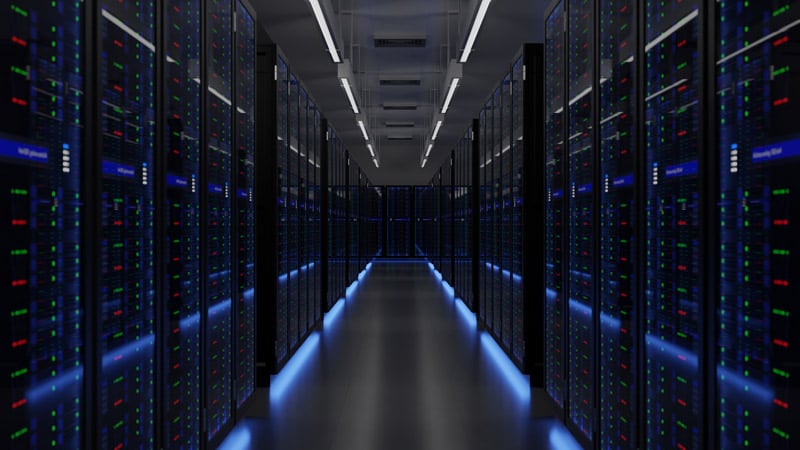Rack-level DC power reduces energy losses, boosts efficiency, and paves the way for environmentally responsible, high-density data centers of tomorrow.
*This blog is the first of a series exploring the rationale for rack-level DC power's growing popularity and how it addresses the challenges of modern data center loads.
Average rack power densities have doubled in just the last two years, from around 8 kW per rack to roughly 17 kW per rack. Projections show they could reach 30 kW or more by 2027 as AI workloads surge. Racks up to 132kW are being deployed in large quantities today. This soaring demand means today’s data centers need efficient, high-density power solutions more than ever to support power-hungry processors and graphic processing units (GPUs) without wasting energy or space.
Traditional AC power architecture designs and deployments require multiple conversion steps and suffer inherent losses in the distribution process, as the energy is lost as heat. Individually, these losses are often estimated at 5–10% per conversion, and overall distribution system inefficiencies commonly account for 10–12% of total data center energy usage. When you string several such conversions together (e.g., grid AC → UPS DC → PDU AC → server DC), those losses accumulate—leading to higher electricity costs, more heat to remove, and limits on how much power you can cram into each rack. In response, data center operators are seeking a better approach.

Figure 1. Architecture 1: Conventional multitenant data center (MTDC) and cloud data center configurations.
Why rack-level DC power is gaining traction
Rack-level DC power distribution is emerging as a scalable, efficient alternative to legacy AC designs. By delivering DC power directly at the rack (and to the servers), this approach eliminates unnecessary conversion steps and significantly cuts energy waste.
- Fewer conversion losses mean higher efficiency. Traditional AC power systems face significant energy losses due to multiple conversion steps: from AC to DC and back multiple times (e.g., utility to UPS, UPS to distribution, server PSUs, and so on), each time losing a fraction of power. Every transition between AC and DC or vice versa adds inefficiencies.
- By contrast, rack-level DC power systems require fewer conversions, reducing overall losses. This gain translates to more of the power drawn from the grid actually reaches the IT equipment. Studies indicate this can save around 10% of power between the utility infeed and the server load. Reduced losses directly lead to lower operating costs and less waste heat, easing the burden on cooling systems.
- Modular scalability for high density. Rack-level DC systems are designed to be modular, allowing data center operators to scale power delivery in step with rising IT loads. Need to support a new batch of GPU servers or an AI training pod? With DC power shelves, operators can slide in additional hot-swappable rectifier modules or add another 33kW shelf on the fly, without major electrical rework or downtime.
- This granularity in scaling is harder to achieve with traditional AC UPS units and PDUs, which tend to add power in larger, less flexible blocks. DC power at the rack lets hyperscale and cloud providers incrementally build up to high-density racks (30, 60, even 100+ kW per rack) as required, all while maintaining high conversion efficiency.
- Improved environmental responsibility with less energy wasted. Reduced energy waste translates to tangible environmental benefits. For example, leading tech companies transitioning from 12V server power to 48V DC distribution have reduced energy losses by over 30%. Such advancements not only improve a data center’s power usage effectiveness (PUE) but also significantly lower its carbon footprint.
- Adoption by industry leaders. Tech giants have pioneered the adoption of 48V DC power solutions, finding them at least 30% more energy efficient for high-performance systems. Telecom and networking industries have relied on 48V DC power for decades in their central offices, a testament to reliability and trust in DC systems for mission-critical uptime. These innovations, integrated into Open Compute Project (OCP) standards, are now steering the data center industry toward DC power adoption as the sector catches up.
- Available today and adaptable to the future. Rack-level DC systems, such as the Vertiv™ PowerDirect Rack, are available and can be implemented today. Operators don’t need to rip-and-replace equipment or an entire site; they seamlessly integrate into existing facilities with AC utility feeds, enabling gradual modernization. By bridging current AC infrastructure with future high-voltage direct current (HVDC) architectures, operators can start optimizing efficiency without waiting for industry-wide HVDC adoption.
Deploying now for a DC-powered future
Rack-level DC power is not just a stopgap solution; it’s a shift in how data centers operate. By cutting energy losses, improving scalability, and enhancing resource-use efficiency, it supports operators in redirecting and preparing their infrastructure for future needs. With industry adoption growing and solutions like Vertiv™ PowerDirect Rack leading the way for this transition, now is the time to explore the advantages of DC power for your data center.
In the second blog of this series, we address the steps and how the implementation of HVDC benefits businesses and data centers’ infrastructure longevity and adaptability in the long-term.









